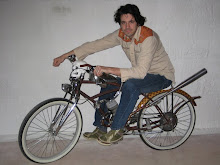



I have slowly and precisely been fitting and carving the Sitka Spruce top plate. The top picture shows the MDF opening pattern with a 1/4" rabit routed around it. The rabit's outer most edge is the dimension of the finished plate. I rout this rabit to be used as a guide to cut on the band saw. After I rout the rabit I glue a 1/4" piece of MDF on the back to stabilize everything and it will also be used for the FHole cutting pattern - you will see what I mean soon 'nuf.
Next, the plate pattern is cut out using the band saw and fitted into the guitar rim opening. I have to sand here and there until the pattern falls into the opening in the rim. It is a fussy procedure and you have to really be aware and use your intuitive at times to read the curve - know the best spot to sand and what parts to leave alone - the rabit's out line is the guide but disappears after some close sanding, creating a bit of a challenge.
If I have too large of a gap in between the MDF pattern and the actual guitar rim opening I sometimes use bondo to build the surface back up for a second chance at perfection. For this guitar the inlay around the rim is going to be 1/16" wide of carbon fiber strands - dead simple, and minimal looking. Carbon Fiber is a very forgiving inlay because it conforms very easily and bends tightly like a dream. It also adds stiffness better than any other inlay. Some luthiers would say "Well how do you get the plate off if you need to do a repair." My answer is "The same way you would take a plate off a guitar with binding - very carefully." The nice thing about my design is that if something catastrophic (crack across the grain) were to happen to the sound plates and they had to be taken off I just trim them off with a dremel and trim to the original opening, then rerout the rabit and make and fit a new plate. It is much easier then trying to preserve a traditional guitar's binding.
After the top curve is defined the back side is carved out and graduated. I do this with my homemade overhead trim router which works very accurately and quickly. If you look close at the 3rd picture you can see the different levels that I have routed to. Generally speaking the middle of the plate is 1/4" thick then a little farther out is an area 3/16" thick and then the outer area is around 1/8" thick. This is where things get really fussy and deadnuts accurate.
How do you voice a plate? Hmmm...with your intuitive, a basic understanding of structural engineering, some physics and a little acoustic vibration science.
When I carve the top plate I use my intuitive and my luthiers eye. I look for the way the plate curve looks and the only considerations are the relationship of the neck angle, scale length and the height of the curve where the bridge is. There is just a small amount of critical geometry but mostly it's by eye - at least that is my approach.
The back carving is much more critical. I think about the equation Force = Mass(Acceleration) F=MA. This equation simply proves that the lighter the instrument the more responsive it will become. One of my themes for this guitar is to save weight everywhere I can. I have taken 1 oz off my tailpiece design, saved a few ozs using a Basswood heel for my neck, saved 1.5 oz and added strength in the neck by laying in Spruce struts, saved about 5oz using lighter tuners and about 9 ozs using Basswood as my glue surface in the rim along with a lighter second layer of carbon fiber and thinning the rim's wood thickness down. 19 ozs of weight savings! That is a major achievement. I predicted a strung weight of 5 lbs 9 ozs for Vicky and I am right on target. By going through this exercise of saving weight I have gained a tremendous amount of insight on my design. I already have ideas for the next guitar where to save weight and how to balance the guitar in the players lap.
Carving the graduations, adding the bracing and tap tuning is what the luthier should never become complacent about. I have strong themes with this part of the guitar and have reflected not only on my own notes but also the science behind frequency vibrations and the relationship between bracing, string tension, vibration dispersal and structural integrity. In a nut shell higher frequencies will vibrate something stiffer and lighter or both and lower frequencies will vibrate something less stiff or heavier or both. This is written about in an article by Jim Blilie in the most recent American Luthierie quarterly.
I have to find a balance when carving the top and bracing. To simplify I have a wider recurve area (less stiff) on the bass side but with heavier bracing - not stiffer bracing - wider for more mass. On the treble side I have a thinner recurve area (more stiff) and will use lighter stiffer bracing. My goal is to get a nice even balance between bass and treble with clear string separation. Archtop guitars do not have the same kind of bass response as a flat top guitar. I want to get close to it without losing the punch the archtop is known for.
More to come...






No comments:
Post a Comment